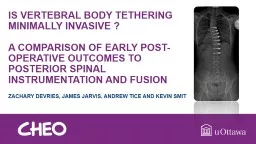

A Comparison of Early PostOperative Outcomes to Posterior Spinal Instrumentation and Fusion Zachary DeVries James Jarvis Andrew Tice and Kevin Smit 2 DISCLOSURE BACKGROUND 3 VBT is a novel surgical technique that utilizes the remaining growth potential in scoliosis patients to corre ID: 933363
Download Presentation The PPT/PDF document "Is Vertebral Body Tethering Minimally In..." is the property of its rightful owner. Permission is granted to download and print the materials on this web site for personal, non-commercial use only, and to display it on your personal computer provided you do not modify the materials and that you retain all copyright notices contained in the materials. By downloading content from our website, you accept the terms of this agreement.
Slide1
Is Vertebral Body Tethering Minimally Invasive ?A Comparison of Early Post-Operative Outcomes to Posterior Spinal Instrumentation and Fusion
Zachary DeVries, James Jarvis, Andrew Tice and Kevin Smit
Slide22
DISCLOSURE
Slide3BACKGROUND3
VBT is a novel surgical technique that utilizes the remaining growth potential in scoliosis patients to correct their spinal deformityCompared to PSIF it is reported as beingLess invasiveMotion sparingImproved recovery timeNo analysis has yet compared the immediate post-operative recovery of vertebral body tethering to that with posterior spinal instrumentation and fusion
Slide4OBJECTIVESTo compare the early post-operative period for adolescent idiopathic scoliosis patients undergoing vertebral body tethering (VBT) to posterior spinal instrumentation and fusion (PSIF)
4
PSIF
VBT
Slide5METHODS5
Retrospective review of 22 VBT patients and 21 age- and curve-matched PSIF patients that underwent surgery between March 2015 and August 2020Features ExtractedDemographic informationPre- and post-operative Cobb angleLength-of-stayPost-operative
complications
Exclusion Criteria
Previous spinal surgery
Neuromuscular or congenital scoliosis
Statistical
Analysis
Student
t
-tests and chi square analysis
Significance set at p<0.05
Slide6RESULTS6
PRE-OPERATIVE
PSIF
(n=21)
VBT (n=22)
p-value
Age (mean)
14.0
±
0.73
12.5 ± 1.4
<0.001*
Sex
(% female)
85.7
95.5
>0.05
Menarch
al
Status (% post-
menarchal
)
66.7%
25.0%
0.015*BMI (kg/m2)22.8 ± 5.020.2 ± 4.60.087Bracing Initiated (% total)33.3%59.1%>0.05Curve Magnitude (mean)60.20 ± 6.155.8 ±6.20.025*
INTRA-OPERATIVEPSIF (n=21)VBT (n=22)p-valueLevels Instrumented (mean)9.6 ± 0.877.8 ± 0.61<0.001*Curve Correction (o)43.50 ± 7.724.40 ± 7.8<0.001*EBL (mL)704 ± 300350 ± 172<0.001*OR time (hrs)5.3 ± 1.04.0 ± 0.72<0.001*
POST-OPERATIVE
PSIF
(n=21)
VBT (n=22)
p-value
Foley Discontinued
(% after POD1)
95.2%
72.7%
0.037*
Day Standing Initiated
(%
after POD0
)
100%
77.3%
0.02*
Day Walking
Initiated
(% after POD1))
95.2%
22.7%
<0.001*
Hours to PCA Discontinuation
(h)
52.3
± 2.7
50.4 ± 13.1
0.52
Hospital LOS (d)
3.5 ± 0.44
3.1 ±
0.46
0.002*
30-day Complication
1
1
0.973
Slide7RESULTS7
Figure 1. Morphine use post-operative in PSIF and VBT patients
Figure 2. PCA Morphine use post-operative in PSIF and VBT patients
Figure 3. Ondansetron use post-operative in PSIF and VBT patients
*
*
Slide8RESULTS – TAKE HOME8
Age
(y)
Curve
(
o
)
OR Time (hr)
EBL (mL)
Standing day 0
Walking day 1
Pain PO#2
(VAS)
PO#2 opioid (mg)
PCA PO#1 (mg)
LOS
(d)
PSF
(21)
14.0 ± 0.7
60.2 ± 6.1
5.3 ± 1.0
704 ± 300
0
5%
3.4±1.758.3 ± 30.769.3 ± 48.53.5 ± 0.44VBT (22)12.5 ± 1.455.8 ± 6.24.0 ± 0.72350 ± 17223%77%2.2±1.433.7 ± 25.937.0 ± 32.53.1 ± 0.46
P-value
<0.05
<0.05
<0.05
<0.05
<0.05
<0.05
<0.05
<0.05
<0.05
<0.05
VBT TAKE HOME: Younger,
curve size, OR time, Blood Loss,
M
obility
,
Pain,
LOS
Slide9CONCLUSION9Compared to PSIF, VBT can be considered less invasive
VBT patients had shorter operating times with less blood lossVBT patients were able to mobilize sooner post-operatively and were discharged from hospital earlier than PSIF patientsVBT patients required less narcotics for pain control compared to PSIFLimitations include difficulties with age and curve-matching the cohorts